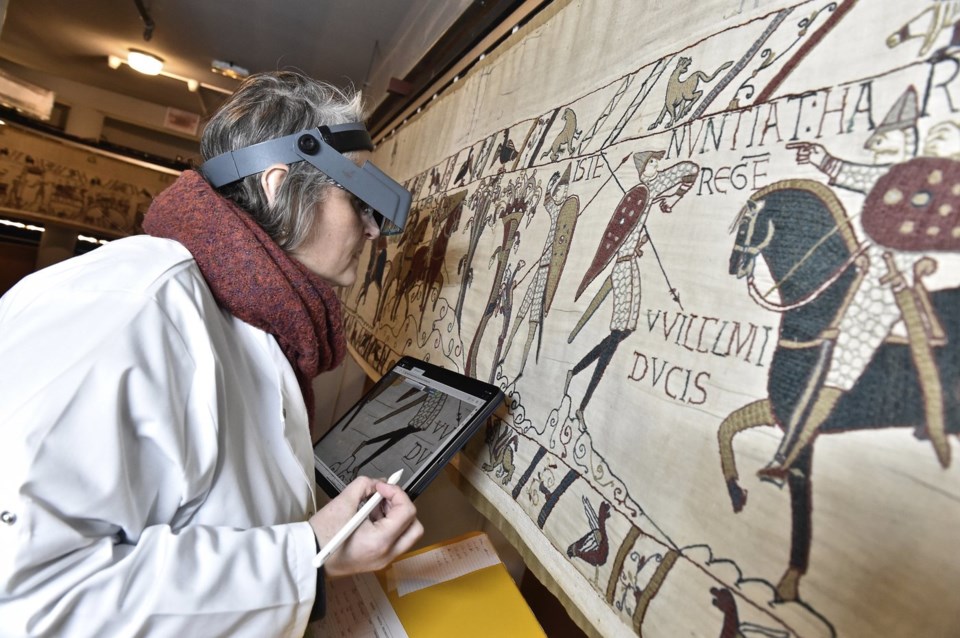LONDON (AP) — The Bayeux Tapestry, a 70-meter- (229 foot)-long medieval artwork that depicts the Norman conquest of England, will be displayed in Britain next year for the first time in 900 years.
It will be exhibited at the British Museum in London from September 2026 to July 2027 as part of a bilateral celebration of the 1,000th anniversary of the birth of William the Conqueror, the French nobleman who led the invasion. The loan was announced during French President Emmanuel Macron's state visit to the UK this week.
Millions of Britons and people from around the world are expected to view this slice of English history — which is normally housed in France at a dedicated museum in Bayeux, in Normandy — while it is on loan to the British Museum. The Bayeux Tapestry Museum will close later this year until 2027 for the construction of new facilities.
Here is a brief history of the Bayeux Tapestry, which shines a light on the long and sometimes bloody links between Britain and France.
Art, propaganda and history
Stitched in wool thread on linen cloth, the tapestry tells the story of the events surrounding the Norman invasion of England.
The story begins in 1064 when Edward the Confessor, the king of England, sends his brother-in-law Harold Godwinson to offer his cousin William, the Duke of Normandy, the succession to the English throne. When Edward died, however, Harold has himself crowned king and William set sail for England to reclaim the throne. The tapestry ends with the epic Battle of Hastings on Oct. 14, 1066, where William’s Normans rout the Anglo-Saxon forces.
Historians suggest the events leading to the invasion were a bit messier. But the artwork in thread tells the story of the victor.
There are banquets, fleets of Viking-style ships, and battles between armored knights wielding swords and spears. The bodies of the dead and wounded are strewn about the battlefield, and one scene depicts Harold pulling an arrow from his eye.
The story is told in 58 scenes that include 626 characters and 202 horses.
While the tapestry is a work of art, it is also considered an accurate account of 11th century life, offering clues about architecture, armor and ships.
Kept in a box for 700 years
Historian’s believe the tapestry was commissioned by Bishop Odo of Bayeux, William’s half-brother, shortly after the events it depicts. Exactly who crafted it is unknown, though evidence suggests the artisans were Anglo-Saxons, according to the Bayeux Tapestry Museum.
For the first 700 years of its existence, the tapestry was a little known church artifact that was hung in Bayeux Cathedral once a year and stored in a wooden chest at other times. According to local lore, it was almost cut up in 1792 during the French Revolution, but was saved by a local lawyer.
The first public displays of the tapestry took place at Bayeux city hall in 1812.
Studied by the Nazis
At the start of World War II the tapestry was placed in an underground shelter in Bayeux for safekeeping. But by 1941 it had attracted the attention of the Nazi’s pseudoscientific ancestral heritage unit, which removed it for study. By the end of the war, the tapestry was at the Louvre in Paris.
After the Allied invasion of Normandy in June of 1944, The New Yorker magazine played off the parallel between those events and the Norman invasion of England nine centuries earlier. The cover of the magazine’s July 15, 1944, edition showed Britain’s King George VI, President Franklin D. Roosevelt and Prime Minister Winston Churchill in a cartoon version of the tapestry alongside Gen. Dwight Eisenhower, the supreme Allied commander, and British Field Marshal Bernard Montgomery.
British authorities highlighted the connection when they built a memorial in Bayeux to honor U.K. and Commonwealth soldiers who died in Normandy.
“We, once conquered by William, have now set free the Conqueror’s native land,” reads the inscription on the memorial.
‘It reeks of male hormones!’
For those who can’t wait until next year, the Reading Museum, 40 miles (65 kilometers) west of London, has a full-size replica of the Bayeux Tapestry.
The “faithful replica” was created in 1885 by 35 skilled female embroiders, according to the museum’s website, though one thing you won’t see in the Reading Museum’s tapestry is genitalia. The Victorian artisans who created the replica worked off glass photographic plates that obscured the spicy details that were included in the original.
“Although a faithful copy, it’s not quite exactly the same,″ said Brendan Carr, the community engagement curator at the Reading Museum. “There are differences that you can spot. So if any visitors to the museum might be shocked by, you know, body parts, then they’re protected if they come to Reading.”
Such niceties didn’t stop an Oxford University historian from counting 93 penises, 88 belonging to horses and five to men, in the original. But earlier this year Dr. Chris Monk, a consultant on medieval history, argued that that an appendage previously thought to be a scabbard was actually another example of male genitalia, pushing the number to 94.
Male genitals are a “mode of emphasis” that articulate machismo, Monk wrote in a blog post.
“A more testosterone-soaked scene is hard to find,” he wrote. “Well, truthfully, there are plenty of scenes of political aggression and posturing in the Bayeux Tapestry: it reeks of male hormones!”
Danica Kirka, The Associated Press



